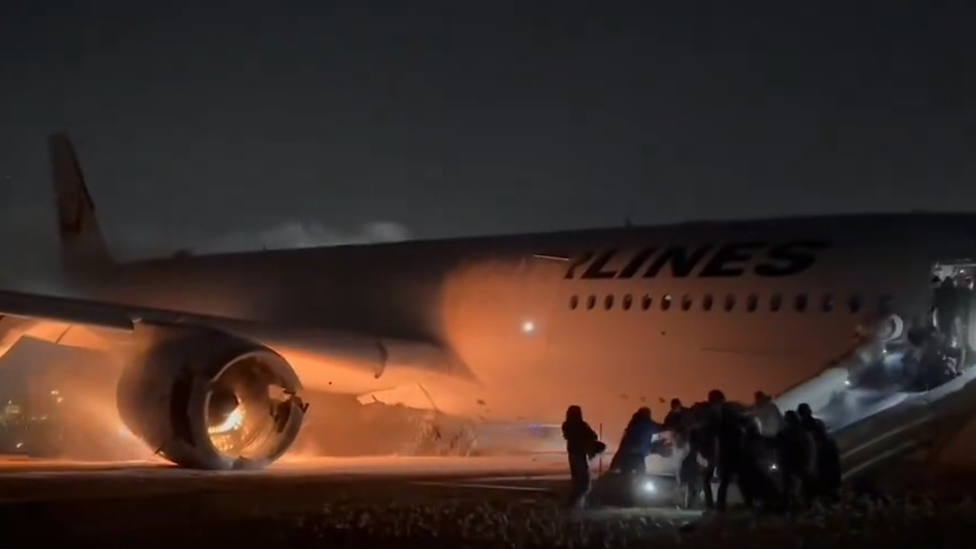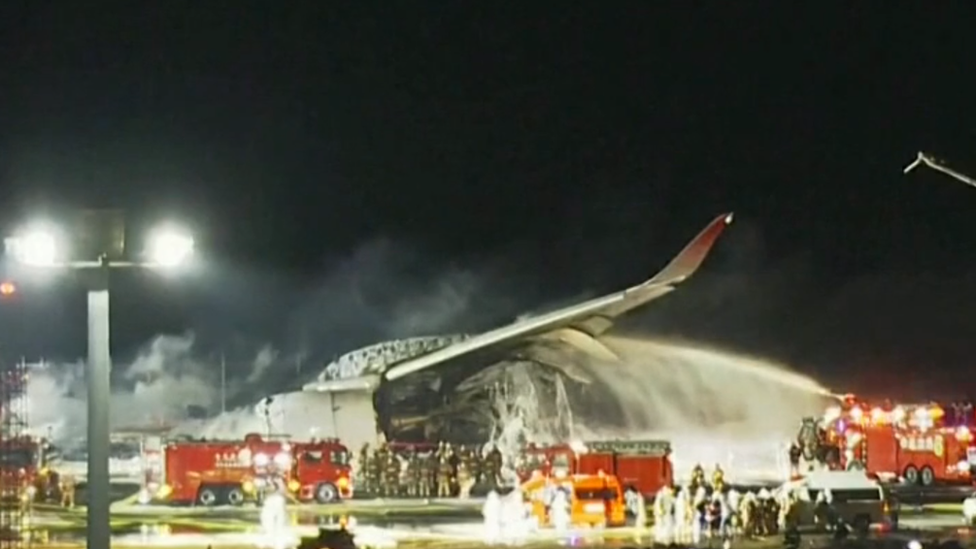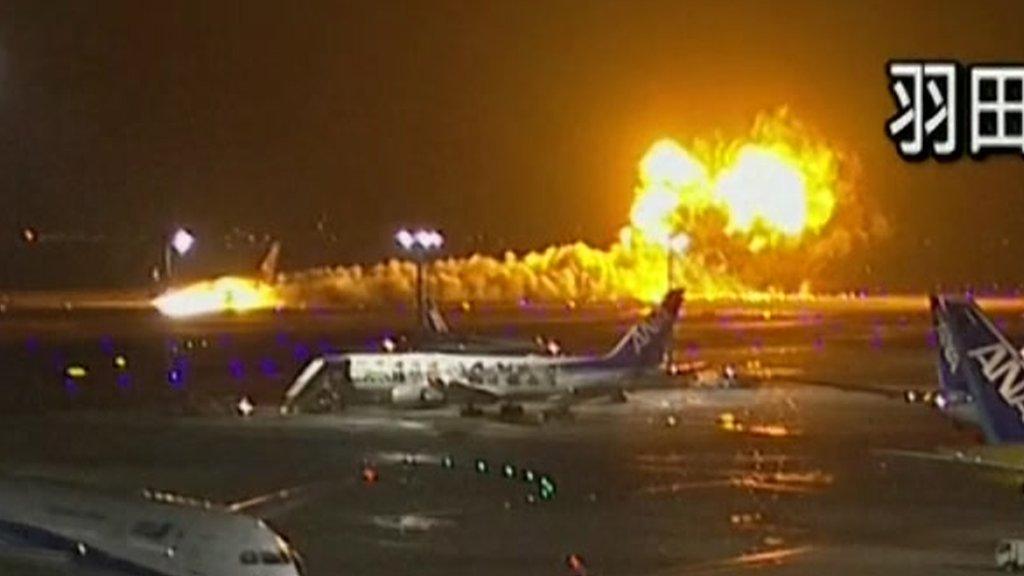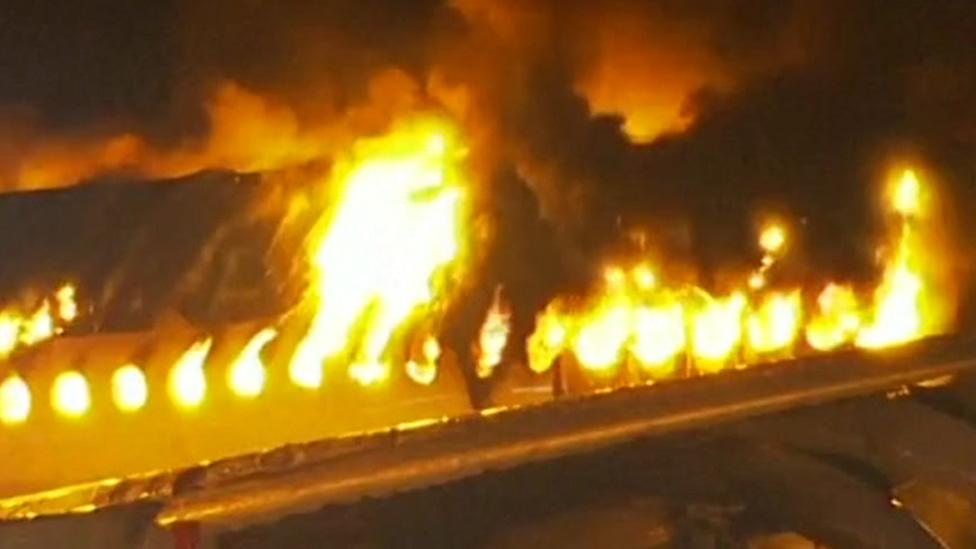Japan jet crash: Passengers describe chaos inside flight 516
- Published

Passengers escape as the jet engine continues to spark
First came the shock, as the Airbus A350 carrying 379 people collided with a second plane while landing in Tokyo.
Then came heat and smoke as the jet sped along the runway in flames.
Then survival instinct kicked in, as people scrambled to flee a cabin filling with fumes, knowing that lives depended on the next few seconds.
That all on Japan Airlines flight 516 escaped is extraordinary. Experts say a flawless evacuation and new technology played a large part in their survival.
Watch: Moment plane turns into fireball as it lands on runway
Those on board the second plane, a smaller coastguard aircraft due to deliver aid to quake victims, were not as fortunate. Five were killed and the pilot is seriously injured.
Investigators are piecing together what happened at 17:47 local time (08:47 GMT) at Haneda airport, and why two planes could have been on the runway at the same time.
For now, videos and statements from passengers paint a picture of a few minutes of terror, then disbelief at what they had lived through.
Swede Anton Deibe, 17, a passenger, described the chaos after impact as the Airbus A350 lumbered to a halt on the runway.
"The entire cabin was filled with smoke within minutes," he told the Swedish newspaper Aftonbladet.
"The smoke in the cabin stung like hell. It was a hell.
"We threw ourselves down on the floor. Then the emergency doors were opened and we threw ourselves at them.
"We had no idea where we were going so we just run out into the field. It was chaos."
He, his parents and his sister managed to escape the wreckage unharmed.

Smoke fills the cabin as passengers prepare to flee
Satoshi Yamake, a 59-year-old passenger, said he felt the aeroplane had "tilted to the side and felt a big bump" in the initial collision.
Another unnamed passenger described a "bump, like the aircraft was colliding with something when touching down. I saw a spark outside the window and the cabin was filled with smoke".
A third reported to Kyodo News he felt "a boom like we had hit something and jerked upward the moment we landed".
Snippets of those moments were caught on phones.
Some passengers filmed the red glow from a still sparking engine as the plane came to a halt. Another took footage inside, a miasma of smoke quickly obscuring the camera lens as passengers shouted and cabin crew tried to direct their next moves.
A female passenger said it had been dark on board as the fire intensified after landing.
"It was getting hot inside the plane, and I thought, to be honest, I wouldn't survive," she told the Japanese broadcaster NHK.
According to another passenger, the escape plan was made more difficult as only one set of doors were used. "An announcement said doors in the back and middle could not be opened. So everyone disembarked from the front," he said.
Images and video show the moment people began to jump down the airliner's inflatable slides - some tumbling in their effort to get away from a now burning cabin, and running to greater safety.
No one appears to be holding their bulky carry-on luggage - a major factor in how quickly a cabin can be cleared.
Alex Macheras, an aviation analyst, told the BBC that the crew "were able to initiate a textbook evacuation" in the crucial first few minutes after impact.
The fire was "isolated to one area" of the Airbus A350 for the initial 90 seconds, allowing them a brief window to get everyone out.
He said the crew were clearly able to understand which doors were away from the flames, which is why pictures show not all the exits were opened for people to escape through.
He added that passengers can slow things down in panic - for example by trying to grab their bags from lockers.
The Airbus A350 is one of the first commercial jets to be made of composite, carbon-fibre materials - which appear to have stood up well to the initial collision and the resulting fire.
All of this was achieved as the fire was quickly spreading to engulf the plane. Video footage showed firefighters battling to contain the blaze, as the plane's fuselage began to break in two.
Mr Yamake, the passenger, said for all of the chaos, it took about five minutes for everyone to get out. "I saw that the fire had spread in about 10, 15 minutes," he added.
Tsubasa Sawada, 28, said he could "only say it was a miracle, we could have died".
It took several hours for the fire to finally be extinguished. Fourteen passengers and crew were treated for minor injuries.
Passengers were already trying to come to terms with that they had just lived through, telling their friends and loved ones that they were okay, and preparing for what was to come.
Mr Sawada had one question. "I want to know why this happened," he said, adding that he did not plan to get on another plane until he got the answer.

The shell of the plane after the fire was extinguished
Related topics
- Published2 January 2024

- Published2 January 2024
